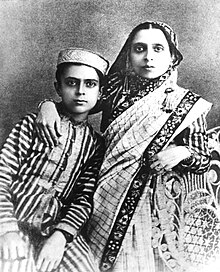
Dejhoor (or Deji-Hor) is a dangling ear ornament worn by Kashmiri Pandits married women, from the day before they are wed in holy matrimony.
The jewelry is placed in the cartilage piercing of the ear in a red thread and later the thread may be replaced with a gold chain known as an ath bought by her in-laws at their house. The thread or chain is about 8-12 inches. The bottom part is athur, which will be of gold, gold /silver threads or pearls, is added attached to the dejhoor. The ornament is not worn by Muslim Kashmiris or any other Hindu community.

It symbolizes union between two Kashmiri Pandit families. The dejhoor ornament is always hexagonal and it symbolizes a yantra denoting Shiva and Shakti.
An interpretation of the term Dij is that it represents "dvija" and is thus the female counterpart of a yajnopavita in the Brahmin community.
Its function is similar to that of a mangal-sutra or sindoor in other regions of India. However a dejhoor is provided by the girl's family and worn even after the death of the husband.
See also
References
- A Study Of The Pandits Of Rural Kashmir, T N Madan, Asia Publishing House, I965, P. 89
- Dr Farooq’s insensitive Dejhor remark aches displaced community: GLR, Daily Excelsior, May 6, 2024
- Ornaments in India: A Study in Culture Trait, Jyoti Sen, Pranab Kumar Das Gupta, 1974
- Simran Kaur , Amita Walia, Simran Kaur , Amita Walia; TJPRC (2018). "Significant Rituals of Kashmiri Pandits, A Perspective" (PDF). International Journal of Textile and Fashion Technology. 8 (4): 11–18. doi:10.24247/ijtftaug20183. ISSN 2250-2378.
{{cite journal}}: CS1 maint: multiple names: authors list (link) - Kanyal, Jyoti (14 February 2020). "Fashion Friday: Breaking down the Kashmiri Pandit look from Shikara". Retrieved 10 September 2021.
This Jammu and Kashmir-related article is a stub. You can help Misplaced Pages by expanding it. |